
Because the month January is „Cervical cancer awareness month“, this blog post is about this type of cancer. Every woman should think about it because it’s a cancer with good chances of healing when it’s detected in an early stage. So use the cancer screening!
The uterus
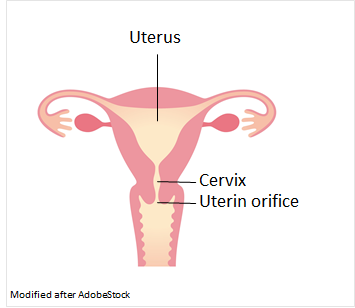
The uterus is used for reproduction: the fertilized egg cell nests and the embryo grows up; during birth the baby is driven outwards by the muscular contractions of the uterus.1
The uterus consists of three parts: the cervix, the isthmus and the uterine body.2,3 Inside the cervix there’s a mucous membrane (epithelium), whose glands form a viscous fluid (cervical mucus) and thus is responsible for pathogens can’t enter the uterus.4 The cervix is a strong muscle tube ending in the uterine orifice.4 This area is particularly vulnerable for cell changes5(cervical or epithelial dysplasia).1
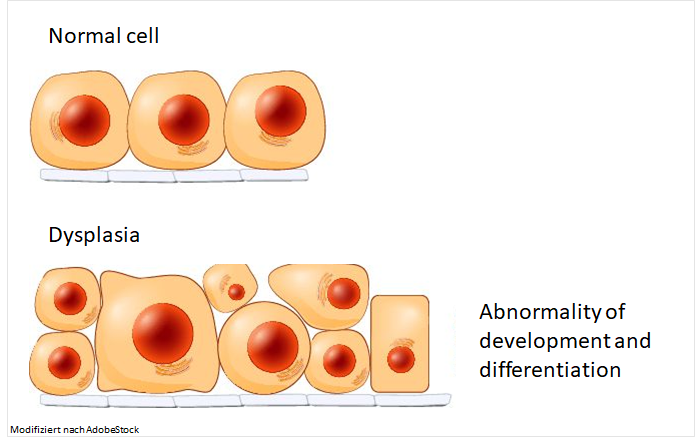
Cervical cancer – preliminary stages
Such cell changes are classified into three degrees of severity, depending how much they are progressed.1 This grouping is called CIN (cervical intraepithelial neoplasia).1,6
- CIN 1 stands for a mild dysplasia, the changes only effect the upper epithelial layer.1,6
- CIN 2 stands for a moderate dysplasia, the changes are already in multiple layers.1,6
- Severe dysplasia is classified as CIN 3, in which the changes affect the entire epithelium.1,6
A diagnosis of such preliminary stages, also known as precancerosis, doesn’t necessarily mean that it develops into cancer, but the probability increases with the degree of severity.1
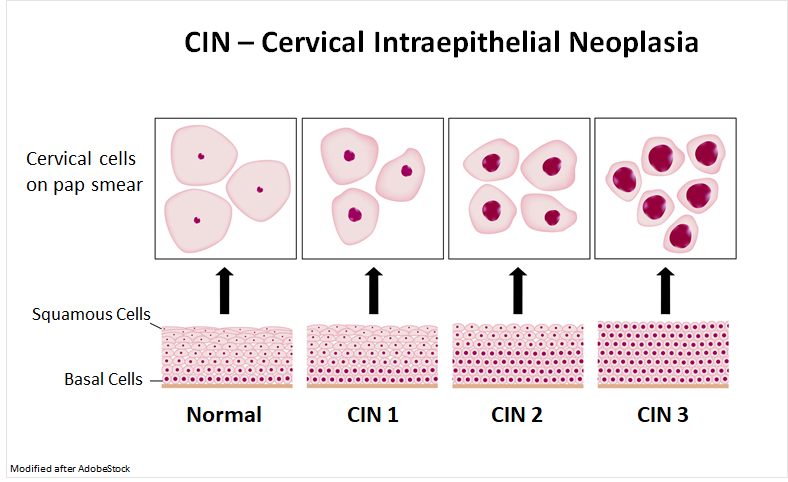
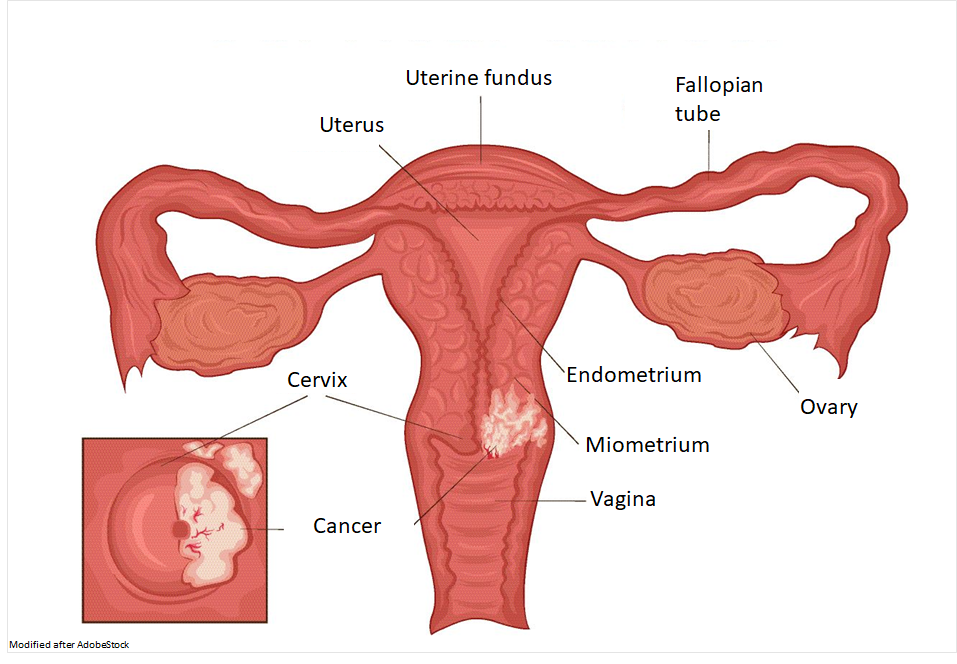
Cervical cancer
Extremely rare – in one out of 100 women – cell changes don’t regress and it end up with cancer.5,8 On average, this process takes around 15 years.7,9,10
Causes
The prerequisite for the development of cervical cancer is an infection with the human papillomavirus (HPV).5
HPV
There are about 100 different HP viruses responsible for various diseases.1,10 Human papillomaviruses predominantly affect skin and mucous membrane cells.4

For example, HPV 6 and HPV 11 cause benign lesions of:
- the skin (warts)1,8
- the mucous membranes of genital and anal bodies (warts)1,8
- the mouth9
- the respiratory8
HPV 16 and HPV 18 are in the development of
- cancer precursors5
- cervical cancer5 involved.
Viruses are microscopically small particles and consist mainly of genetic material and a protective protein coat.7 They’re characterized by the fact that they don’t have their own metabolism and are therefore dependent on a living organism (host) for reproduction.7
HPV 16 and HPV 18 are mainly transmitted during sexual intercourse4,5 or by skin contact in the genital area.4 The viruses settle down in cells of the endometrium.5 Certain genes of the pathogens are incorporated into the genetic material of the affected cells.5 The permanent activity of the foreign genes leads to changes in the host cells.5 If these changes aren’t detected timely cancer can develop.5 Approximately 70% of all cervical cancers cases are due to infections with these two HPV types.5,10
Cofactors
In addition to an infection, the following factors are important:
- Smoking4,7 and passive smoking1: in the mucous membrane of the uterus, carcinogenic degradation products of tobacco smoke can be detected,1 thus pathogens can more easily enter the cells. An infection remains longer in women, who smoke; for former smokers the risk remains elevated for about 20 years after quit smoking7
- Adipositas11
- Many pregnancies/birhts7
- Hormonal contraceptives1
- Addional genital infections1
- Lack of hygiene1
- Unprotected sex1
- AIDS4
- Medications weakening the immune system1,4
Genetic factors seem to have no influence on the development of an infection and on the development of cancer.1
However, it has been shown that women with so-called hormonal coils (IUP = intrauterine pessors) are infected only half as often as women who use other contraceptives.7 However, this isn’t yet fully understood.7 It is believed that the foreign material stimulates the immune response.7
Diagnosis

The Pap test, developed by the greek physician George Nicholas Papanicolaou, has been used for early detection since the mid-1940s.5 This involves taking a smear from the cervix and cervical canal and thus detecting the asymptomatic precancerous lesions.5 They are divided into five stages (Pap I to Pap V).5 From stage three further medical tests are necessary.5 An example is colposcopy where the cervix is examined for cell changes by a magnifying glass.5,9
Epidemiology
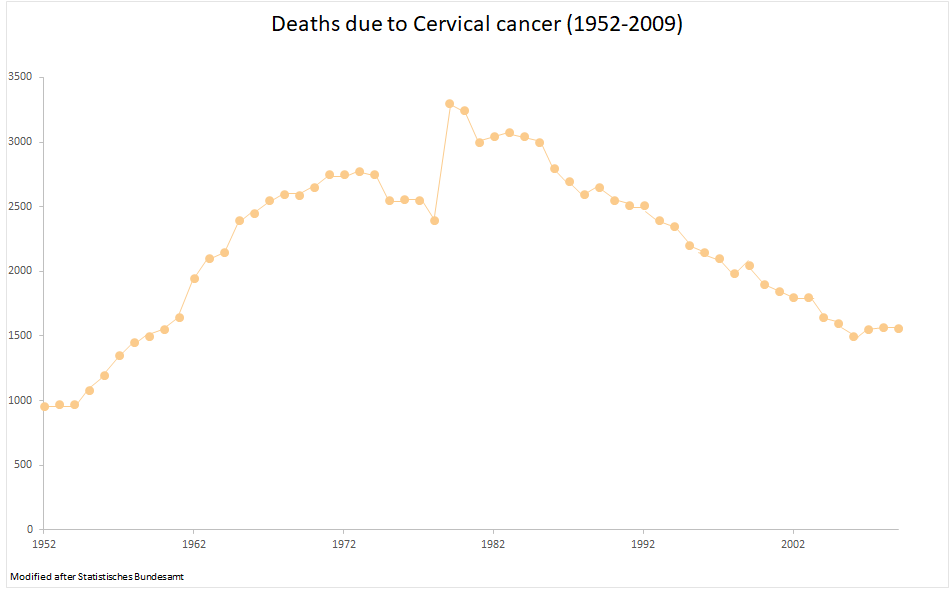
50% of all women become infected with the virus at least once during their lifetime.5 Also re-infection with the same virus is not excluded.5 In most cases, however, an infection pass unnoticed,4 as the immune system successfully fights against it.10,11 If there’s a transient tissue change, it often declines by itself.4,10,11
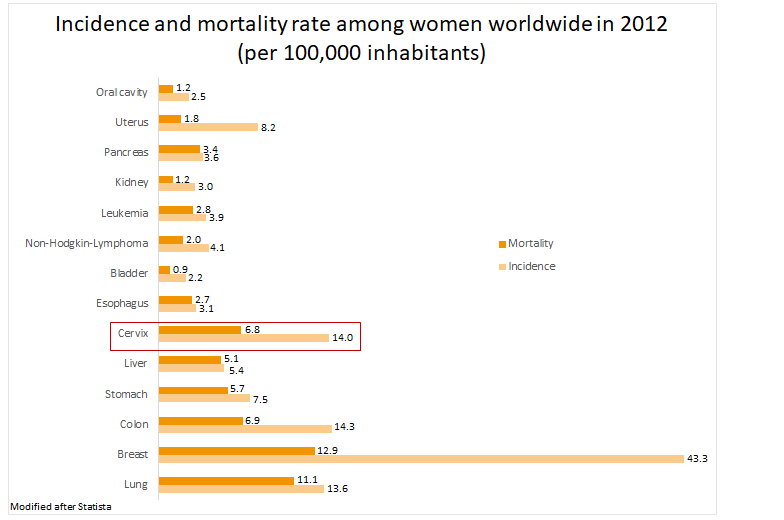
Cervical cancer is more common among younger women.5 Half of the affected are younger than 53 years when they get the diagnosis.1,5 Women between 40 and 59 are the most affected age bracket.5
Cervix cancer is the third most common cancer in the world,13 in Germany, it occupies the twelfth place (as of 2012).1 Also, a decline in the number of deaths can be seen since the 1980s. Nonetheless, this cancer is the fourth leading cause of cancer in Germany among women under the age of 44.12
In Germany, an average of approximately 4,600 women get the diagnosis every year,3,4 but the cancer is detected so early in two-thirds that the chances of recovery are very good.3
The 5-year prevalence indicates that cervix cancer is on the fouth place.14

Symptomes
At the beginning there are no obvious symptoms and appear only as the diasease progresses:5
- Fatigue1
- Irregular menstrual bleeding (after sex,5 outside the period,5 after strain1)
- Unusually long menstrual bleeding1
- Pain during sex4
- Lower abdominal pain1
- Pain during urination/defecation1,9
- Back pain1,9
- Weight loss5
- Noticeably swollen legs1,9
Treatment
There are currently three options available for the treatment of cervical cancer, depending on the size and progress of the tumor:3
- Conization: excision of a part oft he cervix (for very small and early detected tumors)3
- Tracherectomy: partial removal of the cervix (only for small tumors and if the lymph nodes aren’t affected yet)3
- Hysterectomy: removal oft he whole uterus3
In advanced cancer, chemotherapy and radiation are also used.3
Prevention

According to the directive of the early detection of cancer, every woman aged 20 or older has the claim to a free examination once a year.5 Thereby Pap tests are used to analyse cell changes.5
From the age of 35, there is additonal a HPV test detecting the DNA of these viruses.15
Since 2006 there is a vaccine against human papillomaviruses available.13 This is recommended from the age of nine years.13 However, it doesn’t work in people who have already come into contact with the pathogens.13
These cancer screenings are immensely important as the chances of recovery are very high if the tumor is detected and treated in an early stage.5
Australia as a role model
Australia is the world leader in the prevention of cervical cancer and has set the goal of eliminating this type of cancer by 2028.12 In this case eliminating means creating a incidence rate of less than four per 100,000 women per year.12 Experts even expect only six new cases in 100,000 female inhabitants in the next two years.12 Thus, this type of cancer would fall into the category of rare diseases.12 For comparison: In Germany, the incidence rate is twelve per 100,000.12 The number of new cases has fallen extremely in Australia due to a good prevention program.12 For example they switched from the Pap to the HPV test.12 The rate of vaccinations is also very high with a number of 80-90%.12 Compared to Germany: here the rate is 31-43%.12
Future
Both the Pap and the HPV test are in enormous criticism. It is said that the former fails in 20-50% of all cases.12,15 The test for viral DNA is therefor more accurate, but there is no statement about the susceptibility to cancer possible.16
Artificial intelligence

A team of scientists from the National Cancer Institute (NCI) and Global Good has developed an algorithm analyzing digital uterine images to detect the different levels of cancer.17 Artificial intelligence can provide a greater sensitivity than the ordinary Pap test.18
Thus, an even more accurate early detection of precancerous lesions is possible.18
Genetic test
Researchers from the United Kingdom have developed a test that can detect cervical cancer with a rate of 100%.15,16 This was done on 15,744 women aged between 25 and 65 over five years in Canada.15,16 The epigenetic-based test doesn’t search for HPV DNA or cell mutations, but analyzes chemical markers on the genome.16,17 Epigenetics describes all processes altering the activity of a gene in the course of life. Various processes block individual sections of the DNA and is recognized by the novel test.15 So, it is searched for cancer markers within the genome.15
It is expected that the genetic test will be established in England in the next five yeas.15 Compared to the Pap test, this genetic test has a higher accuracy, fewer inspection dates are required and it’s also more cost-effective.15
Therapeutic vaccination
Another goal is to develop a drug for people who already suffer from cervical cancer.19 A first therapeutic vaccine successfully fight against cancer in the mouse model: in half of them, the tumors regressed.19 This treatment option stimulates the immune system so it can kills degenerated cells.19
- Vaccination: the body forms antibodies protecting it from future infections19
- Therapeutic vaccination: activates cytotoxic T cells19
The special feature of this type of vaccine is that the epitopes (potein structures) are an important part of the vaccination itself.13 They are transported into the lymph nodes and can trigger an immune response.13 The cytotoxic T cells come into contact with these proteins and seek out the rest of the body afterwards.13 This kills infected cells/ cancer cells.13
At the moment, this vaccine is in the preclinical development phase.19
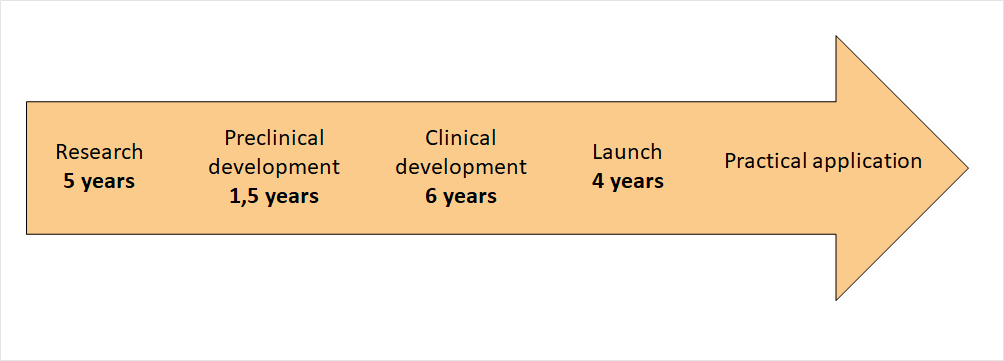
Contact Person:
Kristina Schraml (kristina.schraml@biovariance.com)




